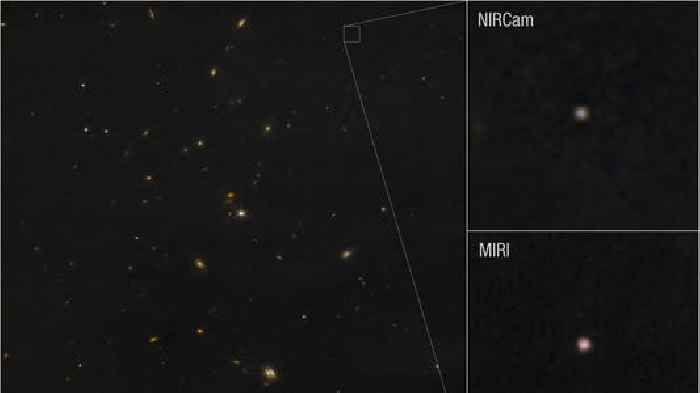Image:
This image shows Webb’s recent observation of the asteroid 2024 YR4 using both its Near-Infrared Camera (NIRCam) and Mid-Infrared Instrument (MIRI). Data from NIRCam shows reflected light, while the MIRI observations show thermal light.
On 8 March 2025, the NASA/ESA/CSA James Webb Space Telescope turned its watchful eye toward asteroid 2024 YR4, which we now know poses no significant threat to Earth in 2032 and beyond.
This is the smallest object targeted by Webb to date, and one of the smallest objects to have its size directly measured.
Observations were taken to study the thermal properties of 2024 YR4, including how quickly it heats up and cools down and how hot it is at its current distance from the Sun. These measurements indicate that this asteroid does not share properties observed in larger asteroids. This is likely a combination of its fast spin and lack of fine-grained sand on its surface. Further research is needed, however this is considered consistent with a surface dominated by rocks that are roughly fist-sized or larger.
Asteroid 2024 YR4 was recently under close watch by the team at ESA's Near Earth Objects Coordination Centre, located in Italy. Planetary defence experts from the Agency's Space Safety programme worked with NASA and the international asteroid community to closely watch this object and refine its orbit, which was eventually determined to not pose a risk of Earth impact. Read details on this unusual campaign via ESA's Rocket Science blog and in news articles here and here.
Webb’s observations indicate that the asteroid measures roughly 60 meters (comparable to the height of a 15-story building).
The new observations from Webb not only provide unique information about 2024 YR4’s size, but can also complement ground-based observations of the object's position to help improve our understanding of the object’s orbit and future trajectory.
Note: This post highlights data from Webb science in progress, which has not yet been through the peer-review process.
[Image description: A collage of three images showing the black expanse of space. Two-thirds of the collage is taken up by the black background sprinkled with small, blurry galaxies in orange, blue, and white. There are two images in a column at the right side of the collage. On the right side of the main image, not far from the top, a very faint dot is outlined with a white square. At the right, there are two zoomed in views of this area. The top box is labeled NIRCam and shows a fuzzy dot at the center of the inset. The bottom box is labeled MIRI and shows a fuzzy pinkish dot.]
Webb snaps photographs of Asteroid 2024 YR4
ESA
0 shares
2 views


